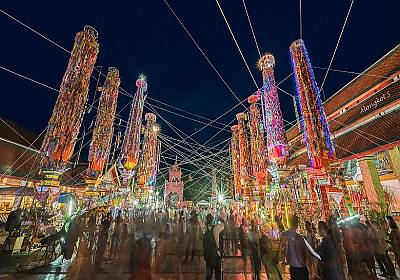- Thailand

The Salak Yom Festival in Lamphun, Thailand

© “Salak-Yom-Traditional” by Alongkot Sumritjearapol is licensed under CC BY-SA 4.0
1. ICH domains
Social practices, rituals, festive events, traditional craftsmanship
2. Short description
Held annually between September and October among the ethnic Yong of Lamphun province in Thailand, the Salak Yom Festival features the presentation of elaborately decorated ‘trees of gifts’ to the Buddhist monks and novices of the local monasteries, in return for merit and blessings for the donors. The centrepiece of the ritual is a tall bamboo pole decorated with thousands of brightly coloured tufted rods, also made out of bamboo, and hung with offerings for the monks, such as alms bowls, robes, blankets, palm leaf manuscript holders, dried foodstuffs and money. The lower halves of the trees are decorated with laypeople’s daily objects like cooking utensils, clothes, fresh fruits and vegetables, small dressers, brooms, and various kinds of containers.
The Salak Yom festival is a local variation of a northern Thai Buddhist ritual known as Kuay Salak. The most striking difference of the Salak Yom from other Kuay Salak rites is the central role of women. The tree was traditionally prepared and offered by young, unmarried women around the age of 20, as an expression of their diligence, skilled craftsmanship and Buddhist piety. It was also considered a rite of passage, marking their marriageability. The ritual also featured the singing of the kalong — a poem describing all aspects of the offering, the female donor and her family. While today communities collectively offer most of the larger Salak Yom trees, the festival remains an occasion that recognizes the integral role of women in northern Thai culture and society.
Further information:
The following links provide a summary of the Salak Yom festival. It includes a detailed video about the ritual:
http://www.sac.or.th/databases/ichlearningresources/index.php/video/82-sa-lak-yom
http://www.sac.or.th/databases/rituals/en/detail.php?id=2
A short film funded by the Thai Ministry of Culture about the festival and its links to gender is available here:
https://www.youtube.com/watch?v=bBh328sFhX4
3. Link with sustainable development
Traditionally, the Salak Yom festival was a rite of passage for young women in ethnic Yong society. Through their participation, young women learned not only the importance of merit-making for their own future happiness and prosperity, but also to commemorate and make merit for the spirits of the deceased, all of which cemented their ties to family and the wider social community. The merit gained from offering at Salak Yom was considered to be equal to the merit gained from ordaining as a Buddhist monk. To this regard, the Salak Yom festival reflects the point made in the Operational Directives that ‘communities and groups pass on their values, norms and expectations related to gender through intangible cultural heritage (VI.1.4.181).’ More broadly, the festival provides a social space for enhancing gender equality through the recognition of women’s roles in the community, Thai culture and society, thereby contributing to SDG 5 on gender equality and the empowerment of women.
4. Questions for reflection
One of the risks related to the sustainability of the festival as an expression of gender equality relates to its recent promotion as a provincial festival and draw for tourists. While government funding has supported increased participation and the visibility of the festival, an unintended effect seems to be a weakened focus on women as the main donors and agents of this practice. The minimum height and components of the Salak Yom trees have been stipulated by the local government to exhibit grandeur qualities. Many women find it discouraging to participate as individual donors like before as it will be too costly for them. Furthermore, the values of young women today have, to some degree, changed from the past. Some of them have become less attached to the spiritual values of merit-making through the festival. The Salak Yom no longer functions as a rite of passage for young women.
What could be done to mitigate the risks? What kinds of policies and programs might support the safeguarding of the Salak Yom festival for the women practicing it?